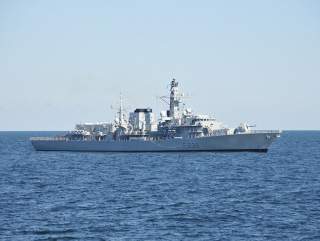Yes, Britain Is Convoying to Protect Its Ships from Iran
Will it work?
Key point: Since the summer, London has been working to protect any of its cargo ships from capture or harassment by Tehran.
The Royal Navy destroyer HMS Duncan has arrived in the Persian Gulf, temporarily doubling the number of British warships in the Persian Gulf following repeated Iranian attacks on British ships.
The brief increase in British warships in the region, from one to two, underscores just how few ships the Royal Navy can deploy even in an emergency. More help likely won’t be coming.
Duncan, a Type 45 destroyer, on July 28, 2019 joined the frigate HMS Montrose escorting vessels sailing under the British flag through the Strait of Hormuz. Naval escorts are an effective way of deterring the kinds of attacks that frequently have occurred in the summer of 2019.
On July 19, 2019 Iranian Revolutionary Guard Corps militia forces seized the British-flagged oil tanker Stena Impero in the Strait of Hormuz, escalating a long-simmering conflict that began after U.S. president Donald Trump withdrew the United States from the 2015 deal that lifted sanctions on Iran in exchange for limits on Iran’s nuclear program.
After Trump restored economic sanctions, Tehran resumed stockpiling uranium. Iran and the West soon began tussling over Persian Gulf shipping.
Royal Marines in early July 2019 seized an oil tanker en route to Syria that British authorities suspected of breaching E.U. sanctions. Authorities told the BBC the ship could be carrying Iranian crude oil to the Baniyas refinery in Syria.
A few days later, Iranian boats tried to “impede” a British oil tanker near the Strait of Hormuz. Montrose, a Type 23 frigate, “was forced to move between the three boats and the tanker,” according to the BBC.
The IRGC also allegedly was behind several recent bomb attacks targeting oil tankers in the Gulf and surrounding waters. Armed men, presumably Iranians, also boarded a second tanker with U.K. ties but did not detain the vessel.
The July 2019 ship incidents compelled the Royal Navy to accelerate by several weeks a planned deployment to the Gulf Duncan. Montrose and Duncan together will patrol the Persian Gulf before Montrose returns to U.K. waters for maintenance.
The previous plan was for Montrose to depart the Gulf before Duncan arrived. The destroyer’s accelerated deployment “will allow a continuous naval presence to be sustained in the Strait of Hormuz,” a British defense ministry spokesman told Jane’s.
The Royal Navy likely cannot keep two major warships in the Persian Gulf for more than a few weeks. After decades of deepening defense cuts, the Royal Navy possesses just 19 destroyers and frigates. Only a few of them are deployable at any given time.
The United States declined to assist British forces. "The responsibility ... falls to the United Kingdom to take care of their ships," U.S. Secretary of State Mike Pompeo said.
London's new defense strategy, released in December 2018, promised to maintain the fleet but not significantly expand it.
Periodic cuts since the fall of the Soviet Union in 1991 have shrunk the British military roughly by half. The most recent rounds of cuts starting in 2010 eliminated, among other forces, two aircraft carriers, two amphibious ships and four frigates, plus the Royal Air Force’s maritime patrol planes and carrier-compatible Harrier jump jets. Uniformed manpower dropped by 30,000.
Fortunately for U.K. forces, funding stabilized at around $55 billion annually. In 2017 and 2018, the government allocated the armed forces an extra $2 billion, combined, above planned spending levels, enough to employ 196,000 active and reserve sailors, soldiers, airmen and civilian personnel.
Banking on the higher level of spending to continue, officials plan on building and maintaining a fleet including two Queen Elizabeth-class carriers, six Type 45 destroyers, eight Type 26 frigates, five low-cost Type 31 frigates, seven Astute-class attack submarine, 24 patrol vessels, 12 minehunters, five amphibious assault ships and nine logistics ships, together embarking six helicopter squadrons and 48 F-35 stealth fighters.
But that fleet still mostly exists on paper.
Mark Sedwill, the government's national security adviser, in May 2018 revealed that the Royal Navy likely wouldn't have enough ships to escort its two new aircraft carriers and would rely on allied navies to protect the carriers during wartime.
That the Royal Navy struggles to maintain two warships in the Persian Gulf, even amid an escalating crisis, reveals just how overstretched the fleet is. The consequences of the warship-shortage could grow more acute if Iranian attacks continue.
David Axe serves as Defense Editor of the National Interest. He is the author of the graphic novels War Fix, War Is Boring and Machete Squad. (This first appeared in July 2019.)
Image: Reuters.

